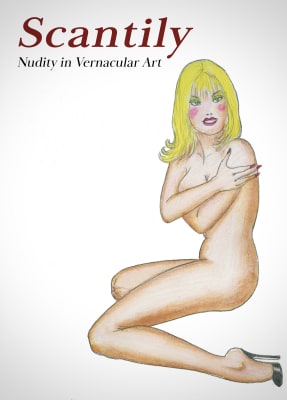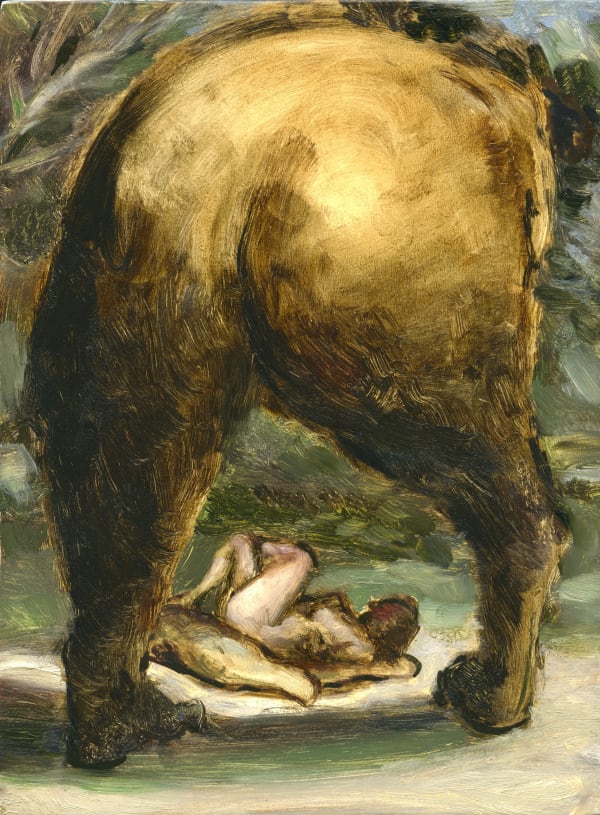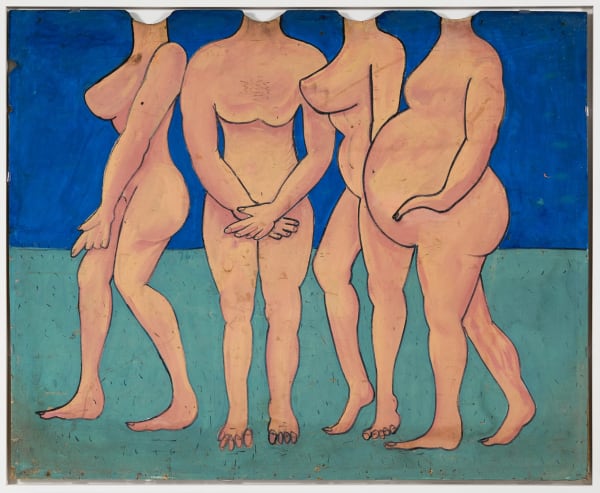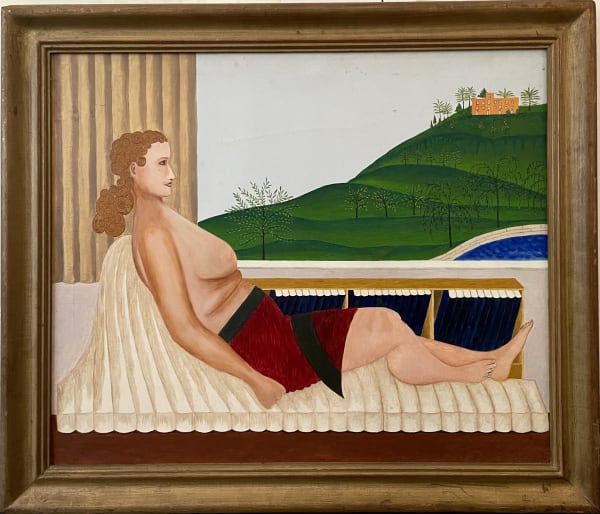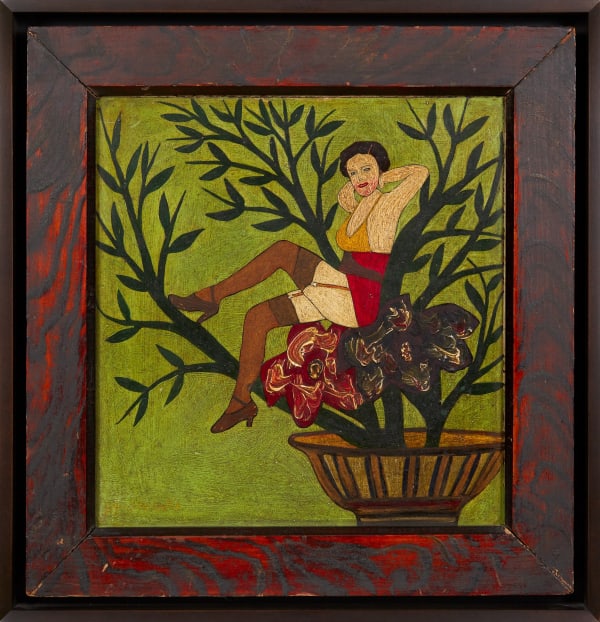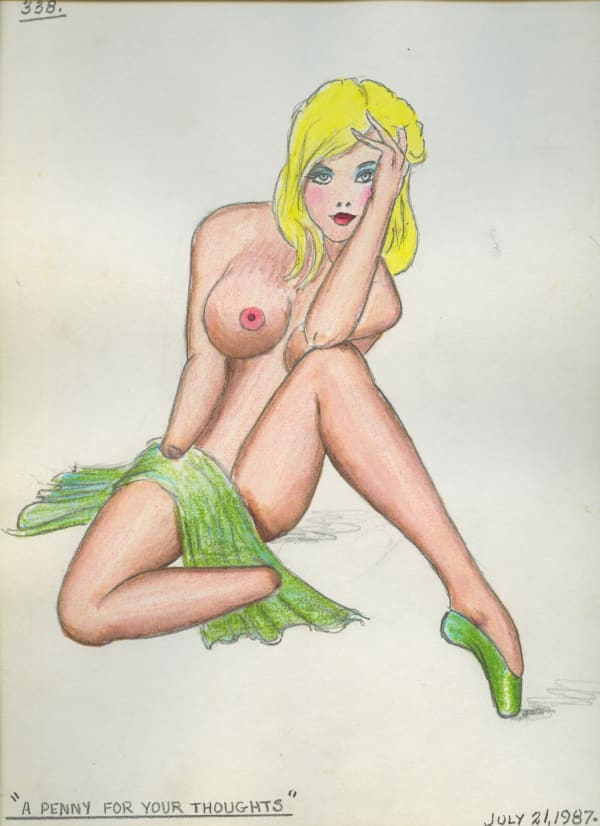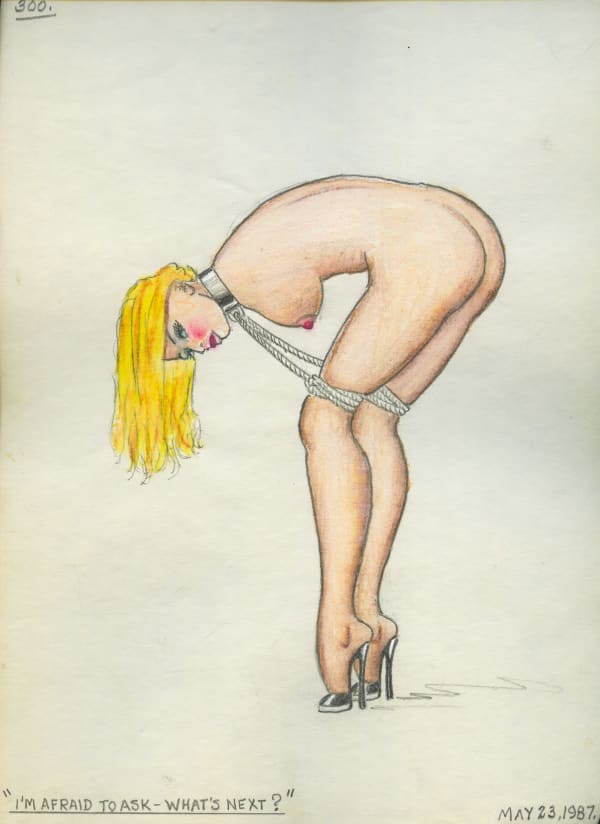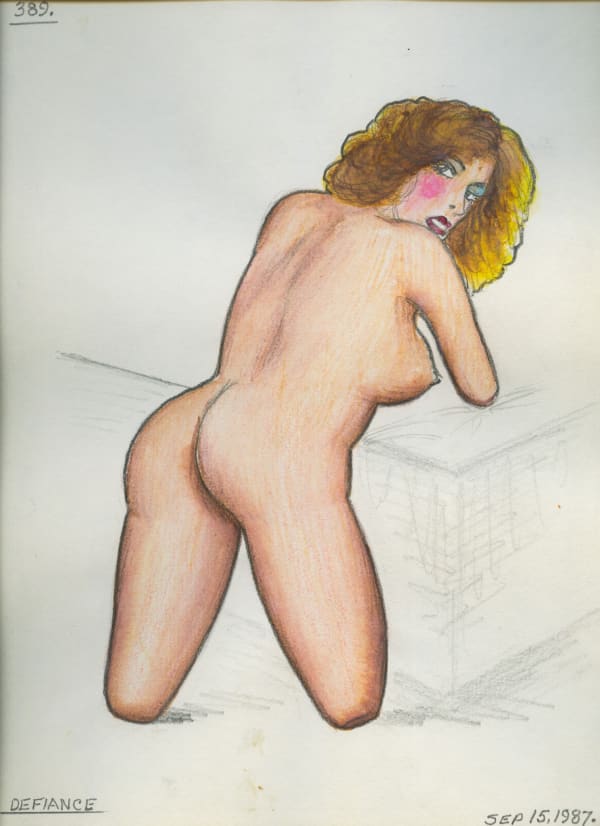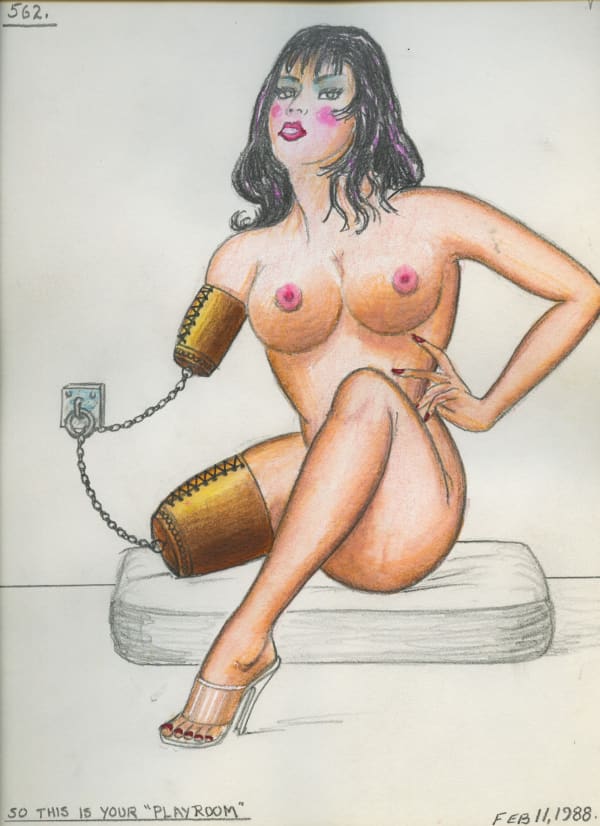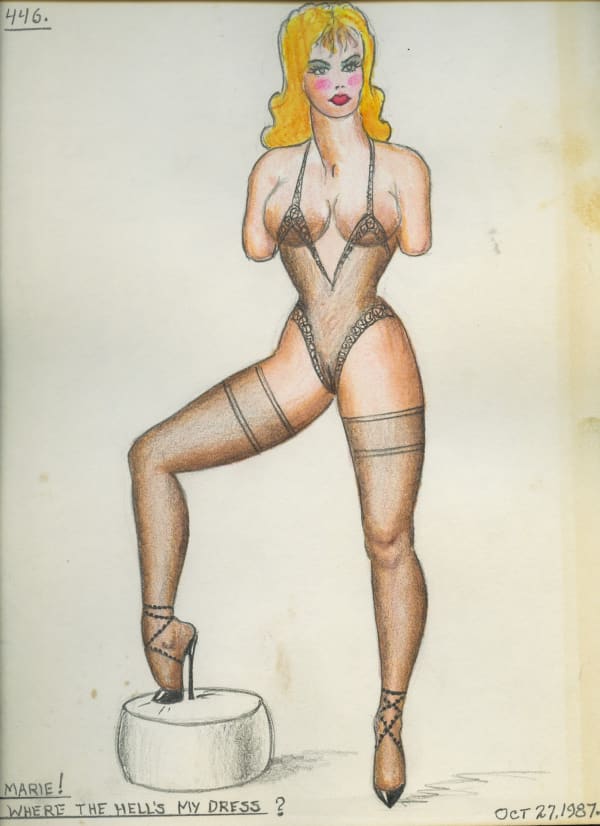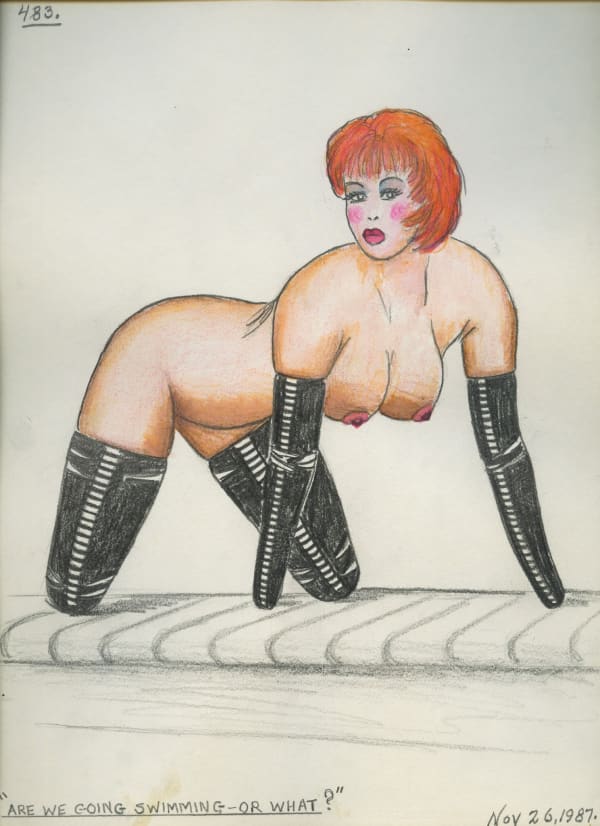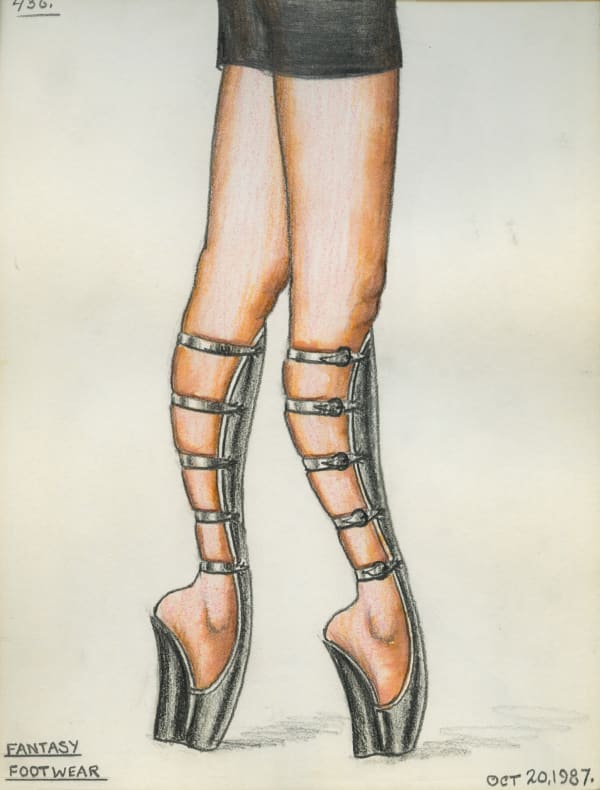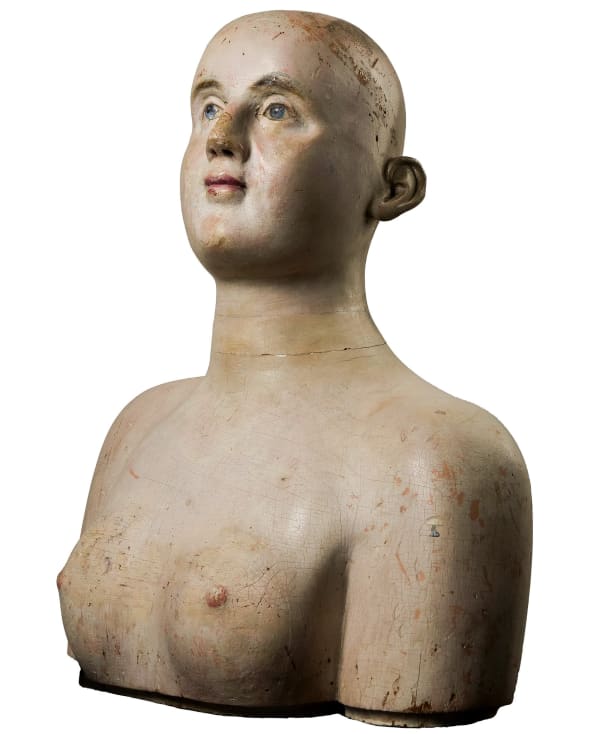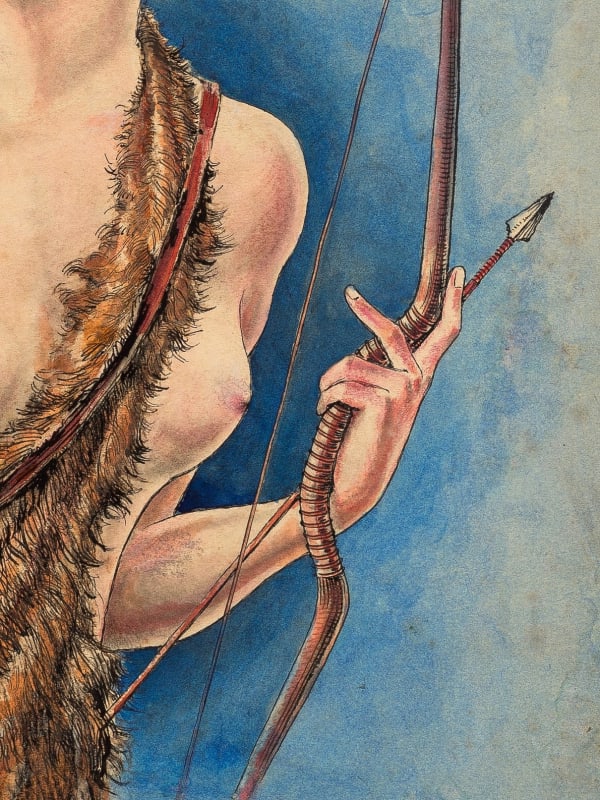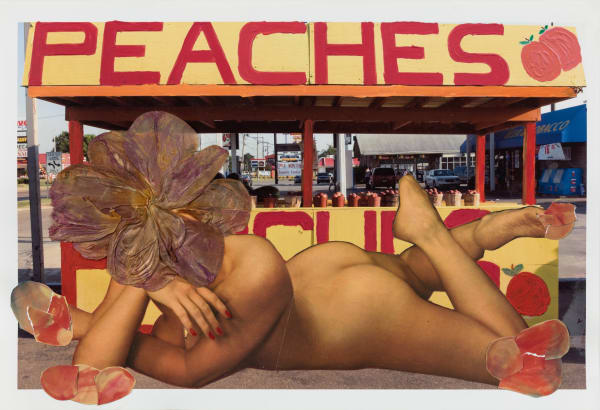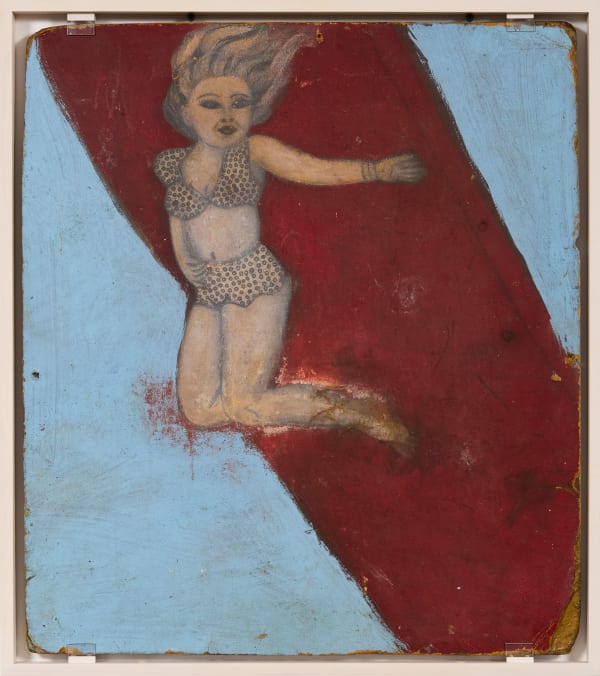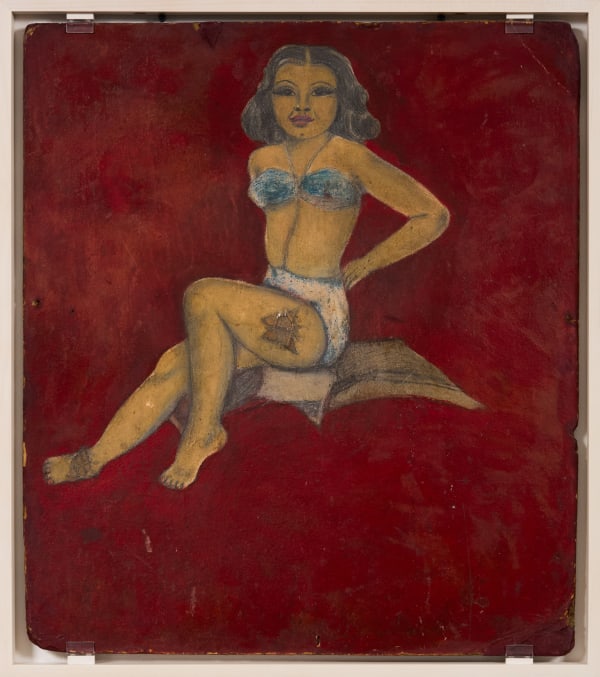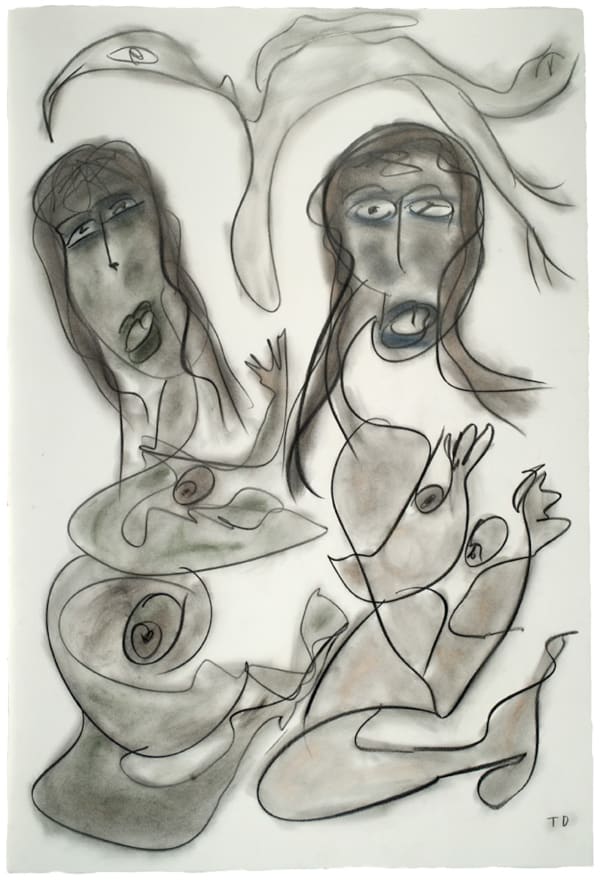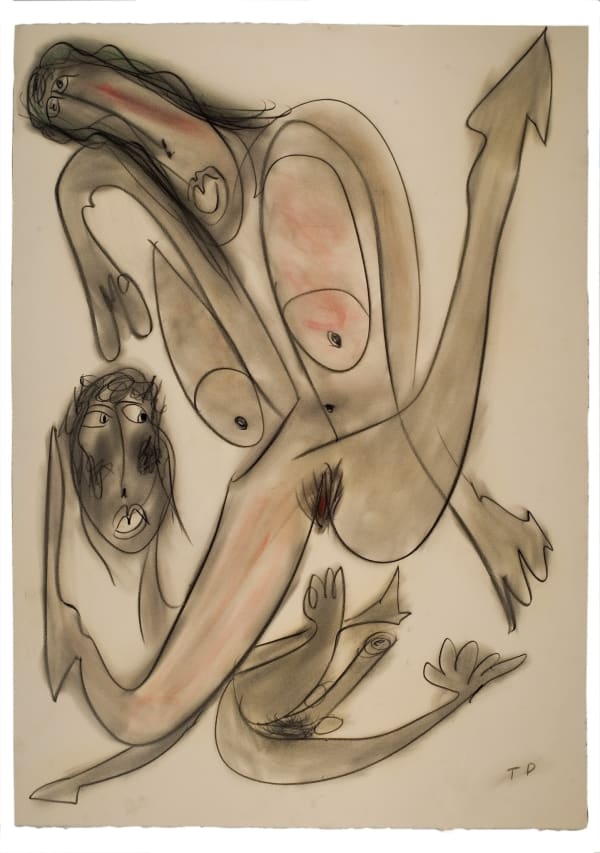The history of the nude runs as far back as art itself. The human nude is the ultimate universal subject—timeless, possessed by all, and yet highly individual and subjective. When it comes to public reception, nudity is divisive at best; from a celebration of the body to the ultimate scandal, no singular person or culture can ever fully agree on just how to display or conceal the bare body. In traditional artistic training, the nude has long been regarded as an essential educational tool, and it’s rare to encounter an academic program that does not insist upon an artist’s understanding of human anatomy. However, where this objective is widely considered as educational, the boundaries between the nude body as artistic, pornographic, and informative are incredibly hazy.
Scantily presents depictions of the nude or partially nude form, as conceived mostly by vernacular, self-taught artists, both known and anonymous. In the art created on the margins of the academy, the human body stands unfiltered by the lens of academia and is instead the full product of the artist’s experience.
-
John D. Monteith (b. 1966)
-
John D. Monteith explores the shadowy, amorphous qualities of the nude figure. The paintings’ subjects are deliberately obscured, hazy, and give off the sense of being partially lost in translation or blurred with time. Based on Monteith’s own re-photographed film stills and original images, the collection of small, intimate paintings evoke a sense of deep recollection akin to Toni Morrison’s “rememory,” and visualize what it means to remember the body when it has been obscured by repression or time. In several paintings, the figures cover their breasts, posed in a manner suggesting shame or shyness towards their exposure, a censorship which is ironically emphasized by the blurring of any true detail. However, within this lack of detail, Monteith’s nude figures have a pronounced presence, a glowing volume that is holographic and visceral. Like fluid ghosts or light-soaked memories, the nudes of Monteith’s 2023 series evoke the lost, intimately remembered people of every viewer’s past, forcing us all to contend with what those close to us can leave behind.
-
Luboš Plný (b. 1961)
-
Where Monteith’s paintings speak to volume in an almost x-ray format, Luboš Plný’s densely intricate drawings evoke human anatomy and the nude in a more academic manner. Complete with both labeled and gestural depictions of human organs, muscles, tendons, and nerve groupings, Plný’s two mixed media works go a step deeper into the nude human subject, and explore the body’s inner makings, depicting an imagined interior functioning of the body that appears almost mechanical or clocklike. Employed as a model at the Academy of Fine Arts in Prague for several years, Plný developed a deep understanding of human anatomy, bolstered by his knowledge of medical literature after being hospitalized early in his adulthood for schizophrenia. With both bold paint strokes and tight, labeled ink illustrations, meticulous yet still somehow gestural, Plný meditates on the many paradoxes of the stripped-down human form: its systems and its oddities, its engineering and its spontaneity. Plný creates a special illusion, uniting academic anatomy with subjective experience of the body; the drawings are created in a manner that evokes scientific structure, but which conveys in actuality an emotional understanding of the nude.
Like Plný’s use of anatomical denotation, Joseph Rappal’s carved wood sculpture, Woman Descending Stairs (1940-45), builds off of the nude of the academy through historical reference. In a direct reference to Marcel Duchamp’s Nude Descending a Staircase No. 2 (1912), Rappal’s sculpture features an unclothed woman, descending the stairs directly towards the viewer, her arms raised welcomingly, and her face painted in an uplifted expression. Where Duchamp’s painting is widely regarded as a modernist classic, extrapolating on the realistic presentation of the nude and transforming it into abstraction and movement, Plný’s piece speaks back to a classical representation of the body, created by someone markedly outside of the classical academy’s walls.
The range of works in Scantily shows us that the body, despite being a universal human experience, has no limits when it comes to interpretation and presentation. When artistic pursuits are more primal, more honest, the engagement with the nude becomes even more real—not formulaic, with proportions to be taught and memorized, but a treatment of the body as a concept, a memory, and an experience.
-
Joseph Rappal
-
A vernacular artist in the furniture industry, few details are known about Joseph Rappal’s biography or artistic practice. One can assume that Woman Descending Stairs originated as a sort of end of day art, created once the vocational workday was done, when the artist had time and resources to himself. After all, there is something distinctly personal and involved about the carving — between the rose engravings and the smaller, miniature nude reclining under the titular staircase, the piece evokes a sense of precious focus on the body, both in its individual exploration of the nude and its connection to its history.
-
Lisa Ivory (b. 1966)
-
 Lisa IvoryPrivate Thoughts, 2022Oil on panel6 x 4 x 3/4 in. (15.2 x 10.2 x 1.9 cm)(LIv 5)
Lisa IvoryPrivate Thoughts, 2022Oil on panel6 x 4 x 3/4 in. (15.2 x 10.2 x 1.9 cm)(LIv 5) -
 Lisa IvoryPrecious, 2022Oil on panel6 x 6 x 3/4 in. (15.2 x 15.2 x 1.9 cm)(LIv 15)
Lisa IvoryPrecious, 2022Oil on panel6 x 6 x 3/4 in. (15.2 x 15.2 x 1.9 cm)(LIv 15) -
 Lisa IvoryCrown, 2022Oil on panel6 x 6 x 3/4 in. (15.2 x 15.2 x 1.9 cm)(LIv 13)
Lisa IvoryCrown, 2022Oil on panel6 x 6 x 3/4 in. (15.2 x 15.2 x 1.9 cm)(LIv 13) -
 Lisa IvoryPick Up, 2022Oil on panel8 x 6 x 3/4 in. (20.3 x 15.2 x 1.9 cm)(LIv 17)
Lisa IvoryPick Up, 2022Oil on panel8 x 6 x 3/4 in. (20.3 x 15.2 x 1.9 cm)(LIv 17)
-
-
In four densely shaded, scratchy oil paintings, Lisa Ivory, a London-based contemporary artist, grapples with her personal relationship between the human and the beast. Ivory’s paintings appear as fuzzy recollections of the primitiveness within us, the animal that lies at the core of human nature. In Private Thoughts (2022) and Crown (2022), large beast-like portraits are obscured by shadowy layers and contrasted by bare, miniature female figures, which circle the fur-covered heads in perpetual dance and motion. In speaking of her work, Ivory describes a desire to connect her inner creature with her human self, and her representation of the beast inside is raw, vulnerable, laid bare to the viewer. There is something more intimate about the semi-abstracted beast than the smaller human nudes above it. By not only peeling back the clothes over the body but also the human façade overlaying the creature within, Ivory’s works truly expand what it means to lay the human subject bare.
-
Artist Unknown
-
Several works in the exhibition focus on the advertised nude, and how fantasy, exaggeration, and the grotesque mix to appeal to the public eye. In one carnival peep-through of nude women “bathers” painted by an unidentified American vernacular artist, the viewer is invited to engage with the nude figure in a more direct format. The painting intends for its audience members to balance their chins in the curved grooves situated at the tops of the necks of the four nude figures; and the audience members consequently assume the identities of the bodies, the faces to the forms. Instead of viewing the piece, the viewer becomes part of the piece itself, enfolded into the spectacle for the carnival’s camera, for a photo to be snapped before the next wave of audience members take their place. One can suppose that those participating in the scene become acutely aware of their association with the nude bodies beneath them, and adopt the vulnerability of their presentation as if it is their own, begging the question: How do our associations with the nude body change when we are responsible for it? The piece depicts four female bodies, completely unclothed and varying in body type, even including one pregnant woman among the cast. Do we look more fondly on the pregnant nude, unconsciously forgiving it based on its connotations with fertility, with life? Or does this change upon adopting the pregnant woman in the peep-through, and would the audience member resting their face above her protruding stomach be the butt of the joke, a humorous spectacle?
-
-
 Untitled (Reclining Semi-Nude), ca. 1950Oil on canvas29 1/2 x 34 1/2 in (74.9 x 87.6 cm)(AU 327)
Untitled (Reclining Semi-Nude), ca. 1950Oil on canvas29 1/2 x 34 1/2 in (74.9 x 87.6 cm)(AU 327) -
 Untitled (Woman on Plant), ca. 1940Oil on Masonite with original grain painted frame15 3/4 x 15 in. (40 x 38.1 cm)(FM Personal 80)SOLD
Untitled (Woman on Plant), ca. 1940Oil on Masonite with original grain painted frame15 3/4 x 15 in. (40 x 38.1 cm)(FM Personal 80)SOLD -
 Louis Berkowitz17th Century Model, 1973Oil on canvas18 1/4 x 14 in. (46.4 x 35.6 cm)(LB 1)SOLD
Louis Berkowitz17th Century Model, 1973Oil on canvas18 1/4 x 14 in. (46.4 x 35.6 cm)(LB 1)SOLD -

-
-
Marcos Bontempo (b. 1969)
-
Returning to the theme of memory and recollection of the human form, there is a hastily recorded air to Marcos Bontempo’s untitled ink drawings that brings to mind the struggle to recall a dream before it fades upon waking. The three paintings, all created in the year 1969, depict nude silhouettes, drawn with ink and made shimmering with sprinkles of salt. The figures sprawl in various positions that appear visceral, emotional, desperate. As though coping with their own experience within the human body, Bontempo’s nudes appear to experience gravity, pain—one silhouette flails with a hand to the forehead as they fall downwards, while another protects their skull in the fetal position, and a third balances themself while they vomit, “spewing” black ink to pool at the bottom of the page. Despite the simplicity of Bontempo’s figures, his nudes are eerily complex: seemingly automatic puddles of ink evoke bundles of muscle, and it is hard for the viewer not to extrapolate moments of sinew and structural anatomy from the deceptively primitive figures.
-
AMPUTEE FETISH DRAWINGS
-
 A Penny For Your Thoughts, 1987Graphite and colored pencil on paper12 x 9 in. (30.5 x 22.9 cm)(ArU 468)
A Penny For Your Thoughts, 1987Graphite and colored pencil on paper12 x 9 in. (30.5 x 22.9 cm)(ArU 468) -
 Please Honey I'm Really Freezing, 1987Graphite and colored pencil on paper12 x 9 in. (30.5 x 22.9 cm)(ArU 461)
Please Honey I'm Really Freezing, 1987Graphite and colored pencil on paper12 x 9 in. (30.5 x 22.9 cm)(ArU 461) -
 I'm Afraid to Ask What's Next, 1987Graphite and colored pencil on paper12 x 9 in. (30.5 x 22.9 cm)(ArU 466)
I'm Afraid to Ask What's Next, 1987Graphite and colored pencil on paper12 x 9 in. (30.5 x 22.9 cm)(ArU 466) -
 Defiance, 1987Graphite and colored pencil on paper12 x 9 in. (30.5 x 22.9 cm)(ArU 463)
Defiance, 1987Graphite and colored pencil on paper12 x 9 in. (30.5 x 22.9 cm)(ArU 463)
-
 So This is Your "Playroom," 1988Graphite and colored pencil on paper12 x 9 in. (30.5 x 22.9 cm)(ArU 464)
So This is Your "Playroom," 1988Graphite and colored pencil on paper12 x 9 in. (30.5 x 22.9 cm)(ArU 464) -
 Marie! Where the Hell's my Dress?, 1987Graphite and colored pencil on paper12 x 9 in. (30.5 x 22.9 cm)(ArU 462)
Marie! Where the Hell's my Dress?, 1987Graphite and colored pencil on paper12 x 9 in. (30.5 x 22.9 cm)(ArU 462) -
 Are We Going Swimming or What?, 1987Graphite and colored pencil on paper12 x 9 in. (30.5 x 22.9 cm)(ArU 465)
Are We Going Swimming or What?, 1987Graphite and colored pencil on paper12 x 9 in. (30.5 x 22.9 cm)(ArU 465) -
 Fantasy Footwear, 1987Graphite and colored pencil on paper12 x 9 in. (30.5 x 22.9 cm)(ArU 467)
Fantasy Footwear, 1987Graphite and colored pencil on paper12 x 9 in. (30.5 x 22.9 cm)(ArU 467)
-
-
Performativity, fetish, and submissiveness round out the exhibition. In a grouping of graphite and colored pencil drawings, an unknown vernacular artist depicts fetishized imagery of nude, minimally clad amputee women, posed for the viewer’s express enjoyment. The focus on the nude body in this extensive collection (of which eight have been chosen for the exhibition) is detailed and deliberate, echoed through the use of definitive graphite lines and delicate, carefully shaded skin, similar to Alberto Vargas’ popular illustrations in Playboy. The women pose in a traditionally promiscuous, inviting fashion, and are advertised as expressly sexual—however, unlike most pornographic imagery, their various states of disability render them notably vulnerable and exposed to the viewer’s gaze. This vulnerability can also be seen through chains and constricting garb, or through the model’s choice to cover her breasts, when able. Unlike Ivory’s inquisition into the “creature” within, or Plný’s exploration of internal human anatomy, this exploration of nudity is markedly exterior and aesthetic. Here, the nudity of the female models is the main spectacle of the artworks, and both unflinchingly objectifies and celebrates their individual bodies and disabilities.
The range of works in Scantily shows us that the body, despite being a universal human experience, has no limits when it comes to interpretation and presentation. When artistic pursuits are more primal, more honest, the engagement with the nude becomes even more real—not formulaic, with proportions to be taught and memorized, but a treatment of the body as a concept, a memory, and an experience.
-
Grant Wallace (1868 - 1954)
-
Photographer Unknown
All works: ca. 1925 - 30. Groups of vintage silver gelatin prints. 17 1/2 x 21 1/2 in. (44.5 x 54.6 cm) • $3,000 ea. -
Drossos P. Skyllas (1912 - 1973)
-
Alfred Neumayr (1958 - 2021)
-
Abigail Frankfurt (b. 1973)
-
Tom Wilkins (1951 - 2007)
-
Ernest Schelling (By Golly)
-
Aaron Holliday (1950 - 2007)
-
Thornton Dial (1928 - 2016)
-
Johann Garber (b. 1947)
-
William Goldman (1856 - 1922)
All works: ca. 1892. Vintage silver gelatin print -
Concurrently on view in Gallery Two:
Thrills and Chills: Unique Circus Poster Maquettes (1925 - 40)
Visit the online viewing room here.
